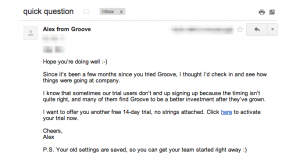Vintage appeal… Clare Press in her Oxford Street boutique. Photo: Tamara Dean
Blame it on the global financial crisis, the rise of the mega-mall, the online shopping revolution or our sky-high dollar but the boutique retail sector is suffering. Clothing and footwear sales declined 4.8 per cent in the year to December and a stroll down any of Sydney’s once-burgeoning shopping precincts will reveal a stream of sale signs and, worse, empty stores.
In the latest twist, retailers have resorted to charging try-on fees in store, which are refunded upon purchase, to stop consumers heading online to search for the same item at a lower price.
Besieged by the new world of e-commerce, it is no longer enough for traditional bricks-and-mortar stores to fill their racks and then wait for the customers to roll in.
Robby Ingham’s store in Paddington. Photo: Tamara Dean
”E-commerce is growing at an exponential rate,” says Katherine Milesi, a partner at Deloitte’s Online Practice, which delivers and implements digital strategies for a number of fashion retailers. Speaking at an e-tail seminar in Melbourne last month, Milesi described the internet shopping boom as ”the black swan Australia
But she believes high-street retailers can coexist happily with the new digital platform. The key to success, Milesi says, is to ensure they differentiate what they provide and the way they provide it.
”Our advice is to create a multi-channel offering where the store, internet and social networking go hand in hand,” she says.
Belinda Seper hosts special events to draw shoppers. Photo: Tamara Dean
”Retailers could encourage customers to go online to browse and then insist they pick up in-store. Or provide an online kiosk inside the store where shoppers can view extended ranges that they can only order online.”
Forced to employ such strategies, niche boutiques and single-brand retailers are becoming increasingly creative about ways to lure consumers away from the keyboard.
”I love having a store because I have an old-fashioned sensibility,” says Sydney designer Clare Press, who opened her Mrs. Press vintage-inspired store on Paddington’s Oxford Street nine months ago. ”I love the traditional shopping experience, a delicious environment, boutique rather than mass, special treatment and a sensory hit that you can’t get online. But as a designer with one store, we have become a destination so you have to work hard as customers are no longer going to walk past and buy a dress on a whim.”
When customers do enter, the fact Press’s work studio is above her store means she is on hand to offer personalised service. She has also created an inviting sensory environment: the boutique smells of magnolia candles and is kitted out like a 1920s boudoir, complete with a black spiral staircase and a gold-velvet theatre chair, and is brimming with vintage treasures collected over the past decade.
”Our clients describe the store as being very European and the decor is all part of the experience,” Press says.
So are the regular salon shows (the most recent to launch the latest racing collection by milliner Suzy O’Rourke), champagne and macaroon shopping nights for VIPs, trend talks by fashion media and a style blog written by Press, a former features director for Vogue Australia.
Also sharpening up their service and rethinking their offering are our well-known luxury fashion retailers, which now find themselves pitted against hugely popular online sites net-a-porter.com and shopbop.com.
”We haven’t changed our philosophy, we don’t sell online, but we have changed the way we market to clients,” says Sydney retail veteran Robby Ingham. ”We have a blog, we email and now we text [customers] the same day new stock arrives.”
Ingham’s high-end Paddington boutique is home to labels such as Stella McCartney, Alexander Wang and Givenchy and has been a Sydney shopping hot spot for 28 years.
”Service has always been at the heart of our business,” he says. ”Going in-store allows you to feel the garment, see the proper colour and fit and bring it back if something goes wrong. We can also do alterations and offer advice on how to maintain pieces.”
Trawling the globe to unearth new and unique labels that suit the Sydney market and regularly changing the mix to keep the offering interesting is core to the sales strategy, as is extensive refurbishment of the store last year to ”refresh the brand and remind customers we’re here”.
”We also have designer meet-and-greets and give our VIPs early notice when a new collection arrives and offer pre-selling,” Ingham says. ”The internet is not going away and as long as international sites are not taxed like an Australian business, they will always have a 20 per cent advantage.”
But the web is ”also a fantastic medium to find out about new labels and keep up with the latest fashion blogs, so you have to go with it”.
The chain of Belinda and The Corner Shop boutiques owned by Belinda Seper in Sydney and Melbourne will soon enter the online shopping space.
But for now the focus remains on enticing customers into the stores via film and fashion nights, photography exhibitions, personal stylists on hand and at-home wardrobe overhaul sessions, should you require the store to come to you.
Seper also employs one-off initiatives such as a tea salon that has been set up at The Corner Shop boutique in Paddington this month, along with VIP launches to showcase new designers, most recently Britain’s Erdem and Christopher Kane.
On the more affordable high street, Sportsgirl is one of the best examples of a retailer that is embracing e-commerce but also updating its bricks-and-mortar stores. Sportsgirl offers a buzzing in-store environment, trendy staff, a dizzying array of well-merchandised racks and a specialised vintage section. It also has services including ”chill out” rooms and ”style me” studios where shoppers can indulge in a one-on-one styling session that is difficult to replicate in cyberspace.
But the long-established chain store has certainly given it a try: the Sportsgirl website features global style reports, a section to learn about Sportsgirl events in your area, regular competitions and blogs and even Sportsgirl TV.
Together, the stores and the website offer a whole-of-brand experience that constitutes an ideal meeting of in-store and online.
Showrooming is one of the biggest threats to retailers today – here are some tips to beat it.

Showrooming is rapidly establishing itself as every retailer’s greatest fear. Smartphone-equipped shoppers can quickly and easily check the prices of goods online and order them from a competitor after viewing the item in your store.
How common is the problem?
Showrooming is on the increase, suggesting that retailer fears are not misplaced.
- 24% of all UK shoppers admitted to showrooming during the 2012 Christmas shopping period.
- 40% of showroomers bought their items elsewhere.
- 20% of showroomers admitted they went instore simply to check an item they planned to buy online later.
The issue of showrooming is not restricted to the UK either. The Yankee Group estimates that 46% of US shoppers use their smartphones to check prices in store.

Some proposed solutions
Many businesses have come up with novel ways to try and combat showrooming:
- A specialist food store has begun levying a $ 5 browsing fee on any shopper who fails to buy anything. The owner Celiac Supplies believes that she was serving 60 people each week who were “just looking”, before going elsewhere to buy the same items cheaper. The $ 5 browsing fee is deducted at the checkout when the shopper makes a purchase.
- Victoria Barnsley, chief executive of HarperCollins has suggested that charging a refundable browsing fee in bookshops is “not that insane”.
- Clothing retailers in Sydney have started charging shoppers “fitting fees”, or to use changing rooms.
- Asda has announced that it is installing free Wi-Fi across its 550 UK stores. Clearly this makes price comparison easier, so it is a confident step by Asda to allow more shopping-time scrutiny of their prices as part of the Asda Price Guarantee, reconfigured for the digital age.
The overall goal of these solutions is the same:
- To deter time-wasters.
- To claim back some of the otherwise-wasted staffing costs.
- To try and create a sense of exclusivity for the shop involved.
The fee-based deterrent has been tried before with little success. Fashion designer Vera Wang once implemented a $ 500 fee for women trying on her gowns, although in that instance she was attempting to stop time-wasters. The fee was abolished after receiving heavy criticism from the media and shoppers alike.
There is a better way
Rather than trying to penalise showroomers, some businesses have unified their multi-channel retail offerings to create a consistent shopping experience across platforms. Some of these new approaches include:
- Developing smartphone apps and encouraging showroomers to download and use them in-store. In this way shops have a second chance at capturing the buyer. Some companies even provide free WiFi to help shoppers get online.
- Using multichannel software, retailers can link web and bricks-and-mortar operations so that the customer can interact with businesses as they choose.
- Pre-showrooming. Encouraging shoppers to reserve or purchase items online and then trying them out in store, backed by a good returns policy.
Showrooming is a definite threat to retailers, but with a good underlying multi-channel platform and some creativity, it is still possible to win. As businesses face up to these challenges, they can also streamline their operations, helping to cut costs and maximise profit.
For more modern retailing insights download the eGuide: eBay and Amazon integration: your route to success
This article was first published on the Sanderson Multi-Channel Blog
Digital & Social Articles on Business 2 Community(144)






